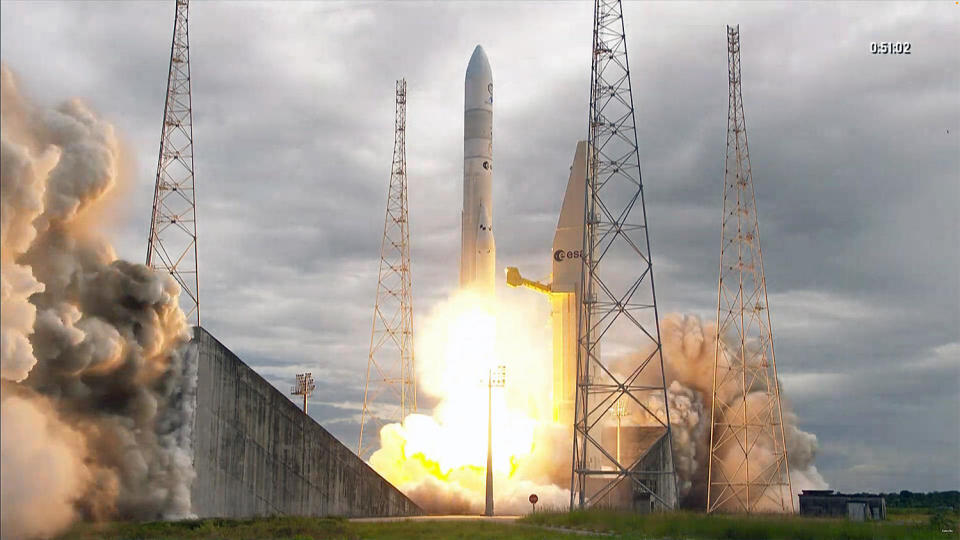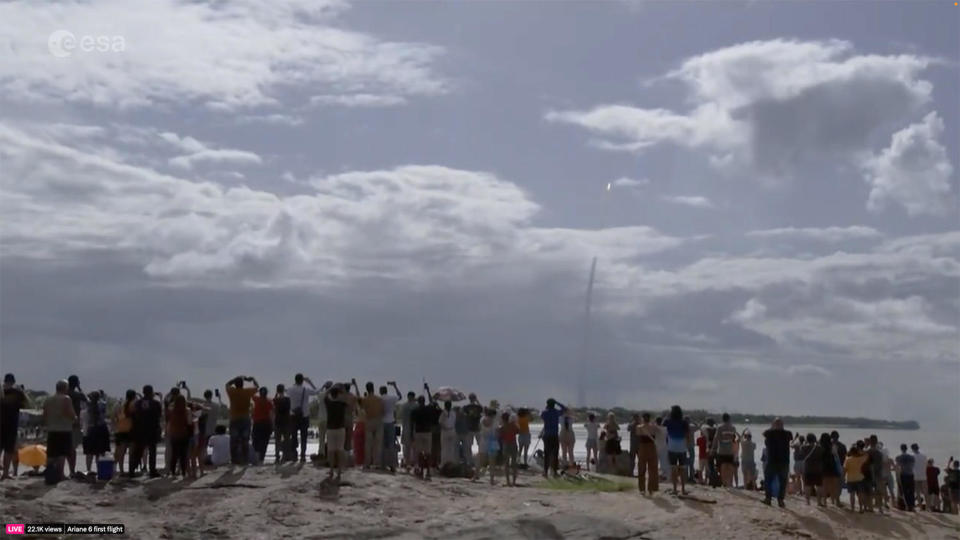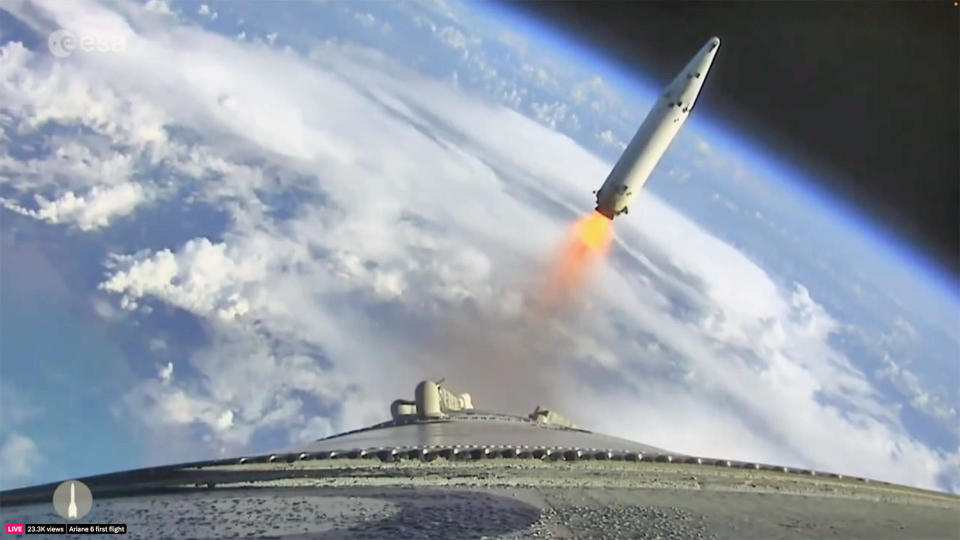Years late, Europe’s new Ariane 6 rocket took off on its maiden flight on Tuesday from the European Space Agency’s launch site in French Guiana in a bid to restore independent European access to space.
Facing increasingly fierce international competition, European space agencies consider Ariane 6 critical to reestablishing and maintaining their position in low Earth orbit and beyond, launching European military satellites, science missions, navigation and communications satellites and other payloads. commercials.

“Ariane 6 will take Europe to space,” said ESA Director General Josef Aschbacher in a post on X. “This is just the first step, we still have a lot of work to do, but we are focused on changing the future of space.” the European space transportation ecosystem.”
Ariane 6 will take Europe to space. Ariane 6 will make history.
Next to the huge #Ariane6 it is indescribable. I feel a wide range of emotions as we prepare to make an impact on European history, Europe’s future and generations of Europeans. This is just the… pic.twitter.com/4B9uB84X55
– Josef Aschbacher (@AschbacherJosef) July 9, 2024
Despite cloudy weather and rain in the area, the 183-foot-tall rocket’s hydrogen-powered Vulcain 2.1 main engine roared to life at 3 p.m. EDT, followed a few seconds later by the ignition of two solid-fuel boosters, each generating 787,000 pounds of impulse.
Ariane 6 soared majestically skyward with a combined thrust of 1.9 million pounds, breaking the afternoon calm at the Guiana Space Center and presenting a spectacular and long-awaited spectacle for government and industry dignitaries, personnel from the launch site and area residents.
Disappearing behind low clouds, both boosters burned and crashed two minutes after takeoff. Vulcain 2.1’s main engine, producing 308,000 pounds of thrust, continued firing for another five minutes before it too shut down and the stage fell, plunging back into the atmosphere where it was expected to break up.


The second stage of the rocket continued its ascent into space. After two firings of its restartable hydrogen-powered Vinci engine, the upper stage reached its planned 360-mile-high initial orbit within an hour of liftoff.
For its maiden flight, Ariane 6 carried several small payloads provided by ESA, NASA, industry, research institutes and students. Among the nine deployable satellites were two small experimental reentry capsules designed to test new heat shield technologies and two NASA “cubesats” built to study radio waves emitted by powerful solar flares.
Three upper stage engine firings were planned over the course of the two hour and 40 minute mission.
Assuming telemetry confirms a successful maiden flight, a second launch is planned before the end of the year. Six flights are booked for 2025, eight flights in 2026 and 10 in 2027. After resolving the current backlog, European space managers hope to maintain a “steady state” of nine launches per year.
“What a huge leap forward for @ESA with the first launch of its powerful next-generation rocket – and with a @NASASun science instrument on board,” said NASA Administrator Bill Nelson in a post on X. “Together with our international partners, we are leading a new era of space exploration.”
Take off, #Ariane6!
What a giant leap forward @ESA with the first launch of its powerful next-generation rocket – and with a @NASASun scientific instrument on board.
Together with our international partners, we lead a new era of space exploration. https://t.co/5IIvCyExtE
-Bill Nelson (@SenBillNelson) July 9, 2024
The launch of Ariane 6 marked an important milestone for the European Space Agency, made up of 13 nations, prime contractor ArianeGroup, French space agency CNES, which built the launch pad, and Arianespace, the consortium that sells and manages the flights. from Ariane.
The rocket’s predecessor, the venerable Ariane 5, was retired last year after 117 flights, including the 2021 launch of the James Webb Space Telescope. The Ariane 6 is roughly comparable to the Ariane 5, but uses upgraded components and is expected to cost 40% less to build and operate.
But on the contrary EspaçoX, which dominates the current launch market with reusable first stages and payload fairings, the Ariane 6 is completely expendable and no components are salvaged. Toni Tolker-Nielsen, ESA’s director of space transportation, recently told Space News that “our launch needs are so low that (reuse) wouldn’t make economic sense.”
“We really don’t need it at this point,” he said. “But when we launch frequently in the future, we will need reusability for economic reasons. The second reason to have reusability for a European launcher is sustainability. We have to have a circular economy within 10 or 20 years, we need to be sustainable .”


The Ariane 6 was originally expected to fly in 2020, but a series of economic and technical obstacles combined to delay the maiden flight by four years.
Meanwhile, a joint program with the Russian space agency Roscosmos – launching medium-sized Soyuz rockets from French Guiana – fell apart after Russia’s invasion of Ukraine. To make matters worse, the small European Vega-C rocket was grounded after its second launch ended in failure.
And so, since the last Ariane 5 flight last July, Europe has not had its own rockets to launch European payloads. In fact, at least four satellites originally scheduled to fly aboard European launchers have been transported to orbit aboard SpaceX Falcon 9 rockets.
“You don’t want to depend on anyone, and that’s why all spacefaring nations want to have their own access to space,” said Lucia Linares, ESA’s director of space transportation and institutional launch strategy, in comments cited by the magazine Nature.
Two variants of the Ariane 6 are planned: one with two belt boosters, the Ariane 62, and a more powerful version, the Ariane 64, with four belt boosters. A variety of payload fairings are available to accommodate different payload sizes.
Tolker-Nielsen said this “modular” system is ideal from Europe’s point of view.
“It’s a perfect system because the Ariane 62 is replacing the Russian Soyuz and the Ariane 64 is replacing the Ariane 5,” he said. “So it covers all our needs. Ariane 6 could be the European flagship for the next 15 to 30 years.”
Havana Syndrome Evidence Suggests Who May Be Responsible for Mysterious Brain Injuries
3D printing a community of 100 homes in Texas and a day on the Moon | 60 minutes












/cdn.vox-cdn.com/uploads/chorus_asset/file/25565579/DSCF0084.jpg?w=300&resize=300,300&ssl=1)





















